Horrific timeline of what would happen in the days, months and years after America is nuked
Forests and cities burning out of control around the world. Rivers and lakes frozen and poisoned by rotting corpses and radiation.
The few people who survived returned to hunting and gathering as agriculture collapsed, leaving the blind, infertile survivors to fight over scraps in the ruins.
These are the dystopian scenes described in a new book that examines in detail how modern civilization would fall apart after a nuclear attack.
Annie Jacobsens Nuclear War: A Scenariopublished in March, is based on exclusive interviews with leading scientists and experts on nuclear winter.
They describe how in the days after multiple nuclear weapons were launched around the world, radioactive soot filled the air for months, causing temperatures in the US to drop to around 40 degrees Fahrenheit (4 degrees Celsius), making farming impossible.
By the time the smoke clears, the ozone layer has been weakened so much that the sun’s rays are causing fatal burns.
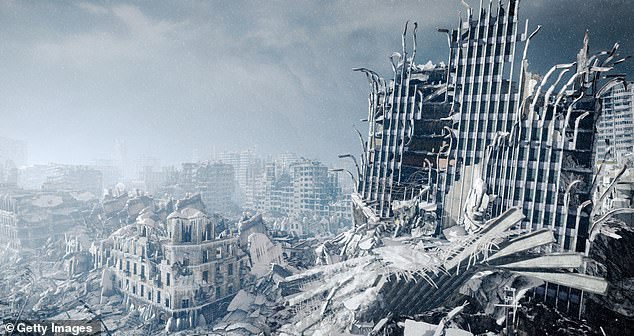
A nuclear war would devastate cities and towns, destroy buildings and large structures, and cause forest fires
Experts predict that a global nuclear war would kill 360 million people almost immediately after the bombs were dropped — but Jacobsen’s book makes clear that these deaths would be just the beginning. Her sources say that 5 billion people would die in the first 72 minutes alone.
She wrote: ‘Most will not get more than a few paces from wherever they happen to be standing when the bomb explodes. They will become what civil defense experts in the 1950s, when these gruesome calculations first emerged, called “Dead When Found.”‘
Those who don’t die immediately face barren land, wildfires, frozen terrain, radiation exposure, no food, widespread destruction and disease.
Minutes after the launch of the nukes: the US is paralyzed
In Jacobsen’s book, she describes a fictional scenario in which North Korea fires intercontinental ballistic missiles (ICBMs) at the United States.
After the US detects the launch, the company responds with a nuclear strike of its own, sending missiles over Russia into North Korea.
Russia then orders its own nuclear attack on the US and allied countries.
Thousands of huge fireballs hit American cities and towns, collapsing buildings and monuments and melting asphalt in every location.
Cities are wiped out. Power grids and nuclear power plants melt down, cutting off electricity and energy and releasing radioactive materials into the air.
Tens of millions of people die almost instantly.
The United States is paralyzed.
Hours after ICBMs strike: Raging fires ravage forests, cities
Wildfires are raging across the Northern Hemisphere, burning nearly everything in America, including cities, crops and forests. Rings of fire extend 100 to 200 miles from each nuclear zero point.
Buildings are set on fire, releasing toxic substances from the materials. Burning insulation and fiberglass spew out cyanides, vinyl chloride, dioxins and furans.
These chemicals damage organs and the nervous system, which can lead to cancer, neurological symptoms and death.
Wildfires are raging in the western states, with radioactive fallout killing conifers and creating fuel for future blazes.
And with water supplies in jeopardy across the country, there is nothing to fight the flames, allowing them to burn freely across America.
Days after the attacks: Radioactive mushroom clouds fill the sky
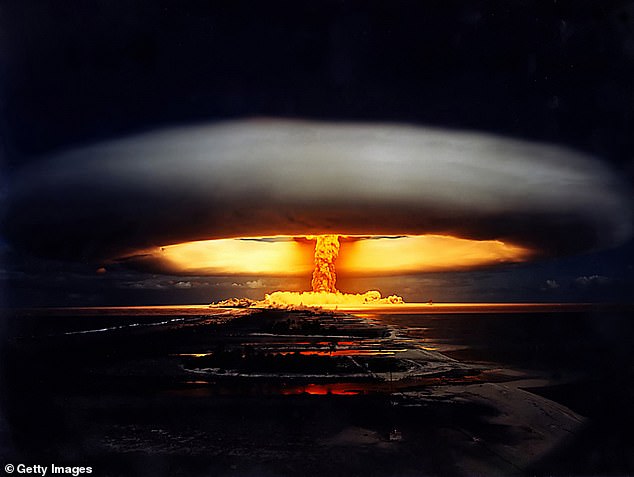
Radioactive dust will fall on all survivors, causing them to become ill and die.
Radioactive products from mushroom clouds, including strontium-90, iodine-131, tritium, cesium-137 and plutonium-239, poison the environment.
These substances damage DNA and have been linked to cancer, chemical burns to the retina and skin, hemorrhaging, coma, and death.
Anyone who survived the initial effects of radiation died from radiation sickness and poisoning, causing nausea, vomiting, fever, dizziness, disorientation, bloody vomit and diarrhea, internal bleeding and infections.
The high exposure to radiation in such a short time causes the inside of the body to liquefy as the blood vessel wall collapses.
The few who survive will suffer chromosomal damage, blindness and infertility.
Weeks after nuclear war breaks out: Soot blankets the atmosphere
In the weeks following ICBM launches, supplies of natural gas, coal in the Earth’s crust, and peat bogs (dense wetlands with decaying vegetation) continue to burn out of control.
As cities and forests around the world go up in flames, approximately 150 billion kilograms of soot are released into the upper troposphere and stratosphere — the lowest and second-lowest layers of Earth’s atmosphere, respectively.
The heavy soot particles block the sun’s rays and temperatures on Earth drop dramatically, sending the Earth into a nuclear winter.
Months after rockets hit: nuclear winter descends on planet
Climate scientist Alan Robock said: ‘The density of soot would reduce global temperatures by about 27 degrees Fahrenheit. In America it would be more like a 40 degree Fahrenheit drop, a little less near the oceans.’
The idea of a “nuclear winter” first came to worldwide attention in a 1983 paper by scientist Carl Sagan.
The first scientific paper explaining this idea was dismissed by the Ministry of Defense as Soviet disinformation. However, newer information shows that many people within the nuclear complex knew that it was a real risk.
Defense Nuclear Agency scientists wrote that after a nuclear attack there would be “atmospheric trauma” and “a high risk of serious consequences.”
The warming rays of the sun are reduced by 70 percent and temperatures drop. The United States and Europe are among the worst affected areas.
In the Central American states, temperatures will not rise above freezing for years.
Due to the lack of sun, many plant and animal life on earth are dying.
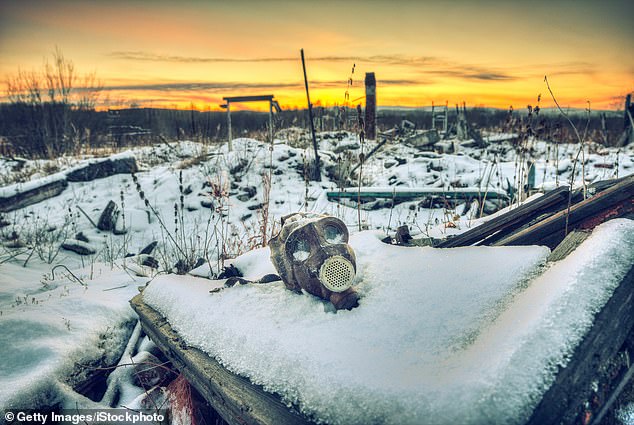
The idea of a ‘nuclear winter’ first came to the world’s attention in a paper by scientist Carl Sagan in 1983
Decades after the consequences: people forced to return to hunter-gatherer modes
Prolonged frost and lack of sunlight have caused rainfall to drop by 50 percent, causing crop losses worldwide.
The surviving humans revert to a hunter-gatherer state, with millions starving and survivors killing each other for the limited food supplies. Humans are forced to scavenge for roots, insects, and the few sources of unpolluted water.
Lakes are frozen under thick layers of ice and other water sources are poisoned by chemicals from industrial plants.
Years after the fallout, as the world finally thaws, millions of dead bodies poison the water supplies and survivors along the coastline discover that filter-feeding shellfish have either died from the radiation or have become too radioactive to eat.
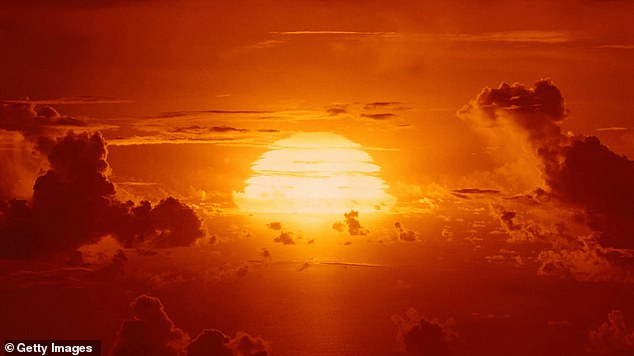
After thousands of hydrogen bombs are dropped on the US, the ozone layer will no longer be able to protect the Earth from the powerful rays of the sun
A few years later, the soot has settled and the ozone layer has lost 75 percent of its shielding power. This allows the strong rays of the sun to reach the earth without a filter, leading to deadly sunburn.
A 2021 study on “Extreme Ozone Loss After Nuclear War” predicted that UV-B levels would become “dangerous to life.”
Survivors were forced to take shelter in caves and cavities.
People would also face plagues as insects multiplied and dead bodies thawed, creating a fertile breeding ground for disease.
Research has shown that insects can survive nuclear war. However, as the Earth warms, insect-borne diseases will also ravage populations of people who are not given antibiotics or medicine.
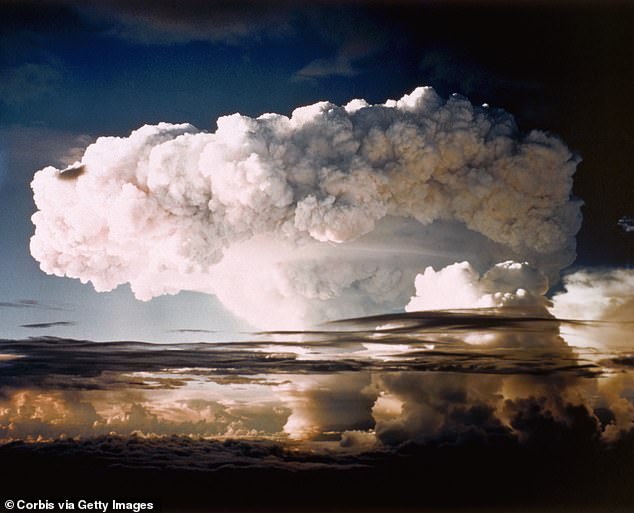
Future civilizations may never understand how ours came to an end
Thousands of years after the nuclear bombings: all evidence of current civilization has been erased
Albert Einstein said the following about nuclear war: ‘I do not know with what weapons the Third World War will be fought, but the Fourth World War will be fought with sticks and stones.’
Even if temperatures return to pre-war levels, the people of the future, still living as hunter-gatherers, may never learn about the people who lived before them and were destroyed by nuclear weapons.
According to Jacobsen, we may never find a trace of modern civilization again and all knowledge from the past will be gone.
She wrote: ‘In time, after a nuclear war, all current knowledge will be gone. Including the knowledge that the enemy was not North Korea, Russia, America, China, Iran or any other nation or group that was reviled.
“It was the nuclear weapons that were the enemy of us all. All along.”
